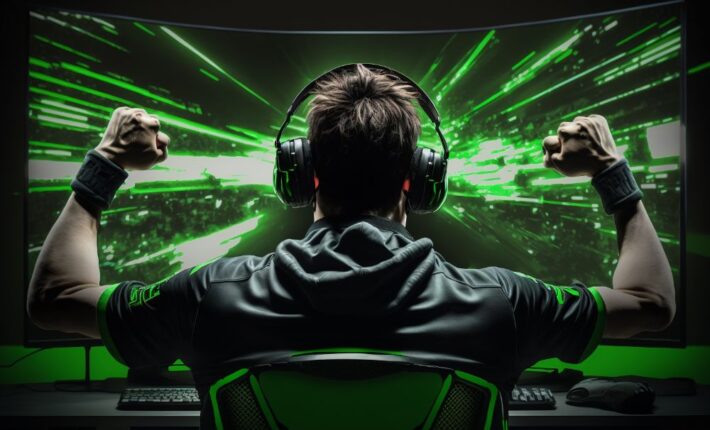Esports has evolved from a niche hobby into a multi-billion-dollar industry. Key revenue streams include sponsorships, advertising, and prize pools.
Platforms such as Twitch and YouTube Gaming are crucial for enhancing viewer engagement and monetization for gamers. Major tournaments now attract substantial audiences and significant investments, positioning esports as a mainstream form of entertainment.
However, challenges such as revenue volatility and unequal prize distribution require careful management. Strategies for sustainable growth in this dynamic landscape include diversifying revenue sources, ensuring fair compensation for participants, and improving regulatory frameworks.
Key Takeaways
- Esports generates substantial revenue primarily through sponsorships, advertising deals, and prize pools.
- Streaming platforms like Twitch and YouTube Gaming are crucial, offering monetization via ads, subscriptions, and donations.
- Major esports tournaments attract millions of viewers, rivaling traditional sports in popularity and engagement.
- Investment opportunities include team ownership, event sponsorships, game development, and esports real estate.
- Economic challenges include revenue volatility and heavy reliance on sponsorships for financial sustainability.
Growth of Esports
Over the past decade, esports have experienced significant growth, evolving from a niche hobby into a global phenomenon. This surge in popularity is evident, as esports tournaments now draw millions of viewers worldwide. Major events like The International and the League of Legends World Championship fill stadiums and attract a substantial online audience, comparable to traditional sports.
The foundation of this growth lies in advancements in technology and the accessibility of high-speed internet, enabling gamers from different regions to compete easily. The impact of social media and streaming platforms like Twitch and YouTube has also been significant, allowing fans to closely follow their favorite players and teams.
Game developers have embraced this trend by creating competitive titles designed for professional play. Games such as Fortnite, Overwatch, and Counter-Strike: Global Offensive have cultivated dedicated communities, driving interest and participation.
Educational institutions have started offering esports programs and scholarships, recognizing the industry’s potential for career opportunities. This institutional support has further legitimized esports, attracting more players and fans.
The growth of esports appears to be continuing at a steady pace.
Also, I recommend reading our article https://bet-of-the-day.net/2024/10/02/the-growth-of-fps-games-in-esports/
Revenue Streams
When you look at the revenue streams in esports, sponsorships and advertising deals play a massive role.
Brands are keen to tap into the engaged audience, offering lucrative contracts to teams and events.
Additionally, tournament prize pools have soared, providing substantial financial incentives for players and organizations.
Sponsorships and Advertising Deals
Sponsorships and advertising deals constitute crucial revenue streams in the economics of esports. For any esports organization, these partnerships hold significant importance. Major brands are interested in reaching the substantial and engaged audiences that esports attract. Companies ranging from energy drink manufacturers to tech firms offer substantial financial backing, enabling organizations to concentrate on player development and infrastructure.
Advertising real estate includes team jerseys, streaming channels, and event stages. In exchange, sponsors provide essential funding that can cover operational costs and potentially enhance player salaries. Sponsorships can also offer additional benefits, such as exclusive gear for players or promotional support for events.
Advertising deals manifest in various formats, such as banner ads on streaming platforms, sponsored content, and social media promotions. These arrangements go beyond merely displaying a logo; they often involve integrated marketing campaigns designed to resonate with the audience.
Tournament Prize Pools
Tournament prize pools are integral to the revenue models of esports organizations. They act as significant incentives for teams and players, encouraging participation and competition. Major tournaments like The International for Dota 2 or the Fortnite World Cup often feature prize pools that reach tens of millions of dollars. These significant sums attract top-tier talent and generate considerable media attention.
Esports organizations depend on these prize pools not only for direct financial gains but also for the credibility and recognition they provide. Performing well in these high-stakes tournaments can elevate an organization’s profile, facilitating the acquisition of sponsorships and investment.
Additionally, strong tournament performances can lead to increased merchandise sales and viewership, further enhancing revenue streams.
Tournament organizers also benefit from the attention generated by large prize pools. They draw larger audiences, which, in turn, attract advertisers and broadcasters willing to pay higher fees for media rights.
This creates a mutually beneficial relationship where prize pools, media rights, and sponsorships reinforce each other, ultimately strengthening the entire esports ecosystem.
Sponsorship Deals
Sponsorship deals play a crucial role in sustaining the esports industry by generating revenue and enabling growth for both teams and individual players. Prominent teams frequently display the logos of established brands on their jerseys, websites, and social media profiles.
These sponsorships provide essential funding that helps cover operational costs, player salaries, and training facilities. They also offer players financial stability, allowing them to concentrate on improving their skills without economic concerns.
Securing a sponsorship deal can significantly impact both teams and individual players. For teams, it means access to more resources and enhanced infrastructure, which can lead to better performance and increased visibility.
For individual players, sponsorships can enhance personal branding and open up further opportunities such as streaming and content creation. Players might endorse products like gaming peripherals, energy drinks, or even automotive brands.
Brands benefit from the extensive exposure to a young, tech-savvy audience that esports provides. They gain direct access to millions of engaged fans who are likely to support brands that sponsor their favorite teams and players.
This mutual benefit allows teams and players to receive necessary funding, while sponsors access a lucrative and expanding market.
Prize Pools
Prize pools are a significant aspect of competitive esports, providing substantial financial rewards that attract players and stakeholders alike. Major tournaments often feature large sums of money, with The International, a leading Dota 2 competition, frequently offering prize pools that exceed $30 million. These financial incentives benefit not only top-tier players but also contribute to the overall ecosystem, affecting everyone from aspiring amateurs to professional players.
The growth of prize pools over the years mirrors the increasing popularity and investment in esports. Financial rewards serve as a strong motivation for players, validating gaming as a potential career path. High-stakes competitions drive players to improve their skills and strategies, which in turn enhances the quality of gameplay and maintains audience interest.
Additionally, many prize pools are partially crowd-funded, with fans contributing through in-game purchases. This method fosters a sense of community involvement, making the competition more engaging for both players and supporters.
Streaming Platforms
When you think about the economics of esports, streaming platforms play a vital role.
They use monetization strategies like ads and subscriptions while employing audience engagement techniques to keep viewers hooked.
With different platforms vying for market share, understanding their dynamics is essential.
Monetization Strategies
Examining the monetization strategies of esports, streaming platforms emerge as a substantial revenue source. Platforms such as Twitch, YouTube Gaming, and Facebook Gaming enable professional gamers and teams to generate income through various means.
Advertising is a key component, with companies paying to place their ads in front of large, engaged audiences. Additionally, subscriber models allow fans to pay a monthly fee for access to exclusive content and perks.
Sponsorship deals also contribute significantly to revenue. Brands often partner with popular streamers to reach their audience, incorporating product placements or branded content.
Affiliate marketing is another revenue stream, where streamers can earn commissions by promoting products, games, or services to their viewers.
Donations and tips from viewers provide another layer of income. Many platforms have built-in tipping systems that facilitate financial support from fans.
Selling merchandise, such as branded clothing or accessories, can further enhance income. By combining these various monetization strategies, streaming platforms present substantial financial opportunities within the esports ecosystem.
Audience Engagement Techniques
Monetization strategies lay the groundwork for financial success in esports, but maintaining audience engagement is equally important. Streaming platforms like Twitch, YouTube Gaming, and Facebook Gaming play a significant role in this by enabling real-time interaction between streamers and viewers, fostering a sense of community that encourages repeat visits.
To engage viewers, tools like live chat, polls, and subscriber-only content can be leveraged. These features enhance interactivity and personalization. For example, effective use of live chat can convert passive viewers into active participants, thereby increasing their emotional investment in the content. Polls can give viewers a sense of involvement by making their opinions feel valued, which can boost engagement levels.
Content diversity is also crucial. Mixing up streams with gameplay, tutorials, Q&A sessions, and behind-the-scenes looks can maintain viewer interest. Regular scheduling helps viewers know when to tune in, which can facilitate the building of a loyal audience.
Collaboration is another effective technique. Partnering with other streamers can introduce new audiences and generate unique content that’s more engaging. Engagement isn’t just about retaining viewers; it’s about turning them into dedicated fans who support monetization efforts.
Platform Market Shares
Understanding platform market shares is important for anyone looking to navigate the esports ecosystem effectively. Knowing where the audience congregates helps in making informed decisions about where to focus efforts.
Currently, Twitch holds a significant portion of the market, capturing over 70% of the viewership. It’s the primary platform for live streaming, largely due to its user-friendly interface and active community.
YouTube Gaming is also growing steadily. Its integration into the broader YouTube ecosystem makes it a strong contender, particularly for archived content.
Facebook Gaming leverages its extensive user base and social features to establish a presence in the market.
Each platform has specific attributes. Twitch is known for live interactions and community-building. YouTube Gaming offers strong searchability and long-term content storage. Facebook Gaming provides effective social sharing and user engagement.
Check out our article The Role of Streaming in Esports to learn more.
Esports Arenas
In the past decade, esports arenas have evolved from modest venues into large, technologically advanced stadiums designed to accommodate thousands of fans. This shift is evident in major esports tournaments, which have moved from small gatherings in internet cafes to events held in notable arenas such as the Staples Center and Madison Square Garden.
These modern arenas are equipped with advanced technology to enhance the viewing experience. Features like giant LED screens, high-quality sound systems, and dynamic lighting effects contribute to making each match engaging for attendees. The enhanced atmosphere is a key factor in why fans are willing to purchase tickets.
In addition to fan engagement, these arenas provide valuable opportunities for sponsors and advertisers. With a significant number of viewers and attendees, companies find these high-profile events attractive for investment.
Brands ranging from technology firms to snack companies are often prominently displayed throughout the venue, capitalizing on the visibility these events offer.
Market Trends
The esports market has experienced significant growth in recent years, driven by increasing viewership, sponsorship deals, and investment from traditional sports organizations. Streaming platforms such as Twitch and YouTube have become prominent venues for esports content. This rise in popularity has resulted in millions of viewers for major tournaments and daily streams, creating a valuable space for advertisers and sponsors.
Sponsorship deals have emerged as a substantial revenue stream. Major brands, including Coca-Cola, Intel, and Nike, are now investing considerably in esports, recognizing the opportunity to engage with younger, tech-savvy audiences. These sponsorships extend beyond large tournaments to include individual teams and players, offering financial support that enables higher levels of competition.
Furthermore, traditional sports organizations are increasingly entering the esports domain, either by establishing their own teams or partnering with existing ones. This integration is merging traditional sports with esports, further expanding the market.
Esports has transitioned from a niche interest to a mainstream entertainment genre with a robust economic ecosystem. Staying informed about these trends is essential for anyone involved in or considering entry into the esports market.
Investment Opportunities
Investment opportunities in esports are expanding, offering varied prospects for both individual investors and large financial institutions. Potential areas for investment include team ownership, tournament sponsorships, and game development. Each avenue presents potential for significant returns.
Esports teams often seek investors to cover operational costs and enhance their competitive capabilities. Owning a stake in a team can provide returns through prize winnings, sponsorship deals, and merchandise sales.
Sponsorship opportunities are also available, as brands aim to reach the growing esports audience. Sponsoring tournaments or individual players can increase visibility and foster brand loyalty.
In the technology sector, investing in game development companies or streaming platforms can be rewarding. These companies are integral to the esports ecosystem, and their growth is linked to the industry’s overall expansion.
Venture capital firms are increasingly interested in startups offering innovative solutions, such as analytics software or virtual reality experiences.
Additionally, esports real estate, including dedicated arenas and training facilities, is a growing field. Investing in these physical assets could be beneficial as the demand for live events and professional training spaces continues to rise.
If you are interested in The Role of Sponsorships in Esports, read this article:https://bet-of-the-day.net/2024/10/02/the-role-of-sponsorships-in-esports/
Economic Challenges
When steering through the economics of esports, you’ll encounter significant challenges like revenue stream volatility and sponsorship dependency issues.
These can create uncertainty and impact long-term sustainability.
Additionally, uneven prize pool distribution often raises concerns about fairness and financial stability for smaller teams and players.
Revenue Stream Volatility
Revenue streams in the esports industry are notably volatile, presenting significant economic challenges for stakeholders. Esports professionals typically depend on various income sources such as tournament winnings, streaming revenue, and merchandise sales.
However, each of these streams is subject to considerable fluctuation due to numerous factors. Tournament earnings are highly contingent on performance and the frequency of events. Poor performance or a reduction in the number of tournaments can lead to substantial decreases in income.
Streaming revenue is similarly unstable, influenced by viewer numbers which can vary based on trends, game popularity, and seasonal factors. This variability complicates income prediction and financial planning.
Merchandise sales also exhibit unpredictability. Market trends change rapidly, and items that are popular today may not sell as well tomorrow. This necessitates continual adaptation of strategies, which can be both time-consuming and financially burdensome.
Given this dynamic environment, understanding and preparing for revenue stream volatility is crucial for managing the financial complexities of the esports industry effectively.
Sponsorship Dependency Issues
In the esports industry, sponsorships play a crucial role in the financial framework, yet they present notable challenges. While sponsorship deals can provide significant funding for teams and tournaments, they also have the potential to create substantial dependency issues. An over-reliance on sponsorships may result in financial instability, particularly when sponsors withdraw unexpectedly or shift their focus to other ventures.
This dependency can impede long-term planning and sustainable growth. Teams and organizations might prioritize immediate financial gains over building a lasting brand or enhancing player development. This focus on short-term benefits can create a cycle where the urgency for immediate funds overshadows strategic investments that could facilitate long-term success.
Additionally, sponsorship agreements often come with specific obligations, such as promoting certain products or services. These requirements may not always align with the team’s values or the interests of their audience, potentially eroding trust and authenticity. This misalignment can alienate fans who perceive the team as compromising its integrity.
To address these issues, diversifying revenue streams is essential. Relying solely on sponsorships isn’t advisable; exploring alternative income sources such as merchandise sales, media rights, and crowdfunding can provide a more stable financial foundation.
Diversification can help mitigate the risks associated with sponsorship dependency, promoting a more balanced and sustainable economic model for esports organizations.
Prize Pool Distribution
Prize pool distribution presents a significant economic challenge in esports. The top-heavy nature of prize allocations in major tournaments often results in the majority of the prize money being awarded to the top few teams, leaving minimal financial rewards for those who don’t finish at the top.
This distribution model can create financial instability for many players. If only the top 1% of players earn most of the prize money, the remaining 99% may struggle to sustain their careers. This disparity can hinder growth and innovation within the industry.
While securing sponsorships might offer some financial relief, not all players or teams possess the marketability to attract such deals. As a result, many skilled individuals face financial uncertainty despite their abilities.
Future Prospects
The future of esports shows significant potential, driven by ongoing technological advancements and a growing global interest. Developments in VR (Virtual Reality) and AR (Augmented Reality) are expected to make gameplay more immersive. These technologies are anticipated to enhance player experiences and improve viewer engagement.
Mainstream media coverage is likely to increase, alongside larger sponsorship deals, as brands recognize the market’s value.
Educational programs related to esports are also on the rise. An increasing number of universities and colleges are starting to offer scholarships and courses focused on various aspects of gaming, including business management and game design. This trend is expected to create a more skilled workforce and contribute to the industry’s overall professionalism.
Moreover, global expansion is a notable trend. Esports is experiencing rapid growth in regions such as Southeast Asia, South America, and Africa. New leagues and tournaments are emerging, providing more opportunities for talent to develop and for businesses to invest.
Conclusion
You’ve seen how esports has grown into a major industry with diverse revenue streams like sponsorships, prize pools, and streaming platforms. While the market trends and investment opportunities look promising, you’ll need to navigate challenges like revenue volatility and unequal prize distribution. By staying informed and adaptable, you can contribute to the sustainable growth of this exciting field. The future of esports is bright, and it’s up to you to help shape it.










